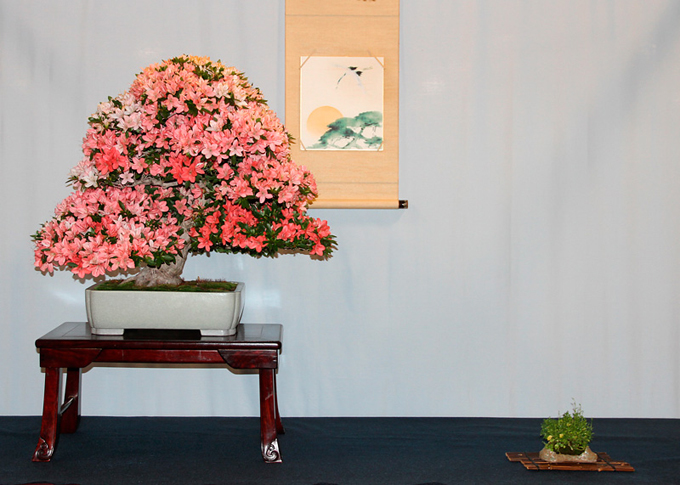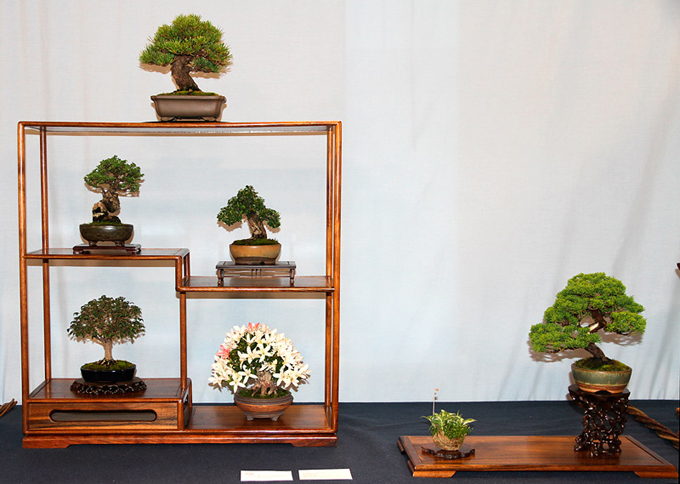 Winner of the Yoshimura Award. It’s a Nikko Satsuki Azalea by Robert Blankfield of Rochester, New York.
Winner of the Yoshimura Award. It’s a Nikko Satsuki Azalea by Robert Blankfield of Rochester, New York.
Round two
This is our second posting of the winners of the 3rd U.S. National Bonsai Exhibition which was held two weeks ago. We still have some to show, so stand by for a third posting.
Night and day
The photos from the 3rd U.S. National Bonsai Exhibition are professional and well done. However, the difference between seeing the splendid power of top quality bonsai up close and personal, and photos of those same top quality bonsai are, to borrow a common phrase, like night and day. Really. If you were there, you know what I mean. If you weren’t, well, I hope you enjoy the photos.
Courtesy of Bill Valavanis
All the photos shown in this post are courtesy of Bill Valavanis. You can to go Bill’s posting on the Internet Bonsai Club if you’d like to see all the winners in one place and read Bill’s comments.
 Finest Shohin Bonsai Composition; mixed species. By Melvyn Goldstein of Euclid, Ohio.
Finest Shohin Bonsai Composition; mixed species. By Melvyn Goldstein of Euclid, Ohio.
 Finest Tropical Bonsai. By Michael Sullivan of Cooper City, Florida. Bill identifies it simply as a ‘Nia’ which I take to be Nia buxifolia.
Finest Tropical Bonsai. By Michael Sullivan of Cooper City, Florida. Bill identifies it simply as a ‘Nia’ which I take to be Nia buxifolia.
One of the finest displays of Bonsai I have ever personally viewed with my own eyes. Who ever says American Bonsai are sub par compared to the Japanese or Europeans has never attended one of Bills shows. Melvyn’s Shohin display rivals anything I’ve seen in print or in person. Was hanging with Melvyn out at Frank Mihalics Wildwood Bonsai Gardens this past weekend- what a super nice guy. As were all of the wonderful new friends I met at the National. See you all there in 2014…
Wayne,
A little history on the Neea buxifolia. In the late ’80’s, Mr. Carlos W. Consuegra of Miami, Florida visited Puerto Rico to conduct several lectures and demonstrations. This was the first time that he had seen Neea and, of course, he wanted one!!! Needless to say, Pedro Morales, presented Carlos with the Neea you feature in this post. Of course, it was untrained material and had just been uprooted from it’s mountain habitat a few months prior. As such, Carlos Consuegra took the tree home and trained it to a fine specimen, not unlike what you see in its present form.
This tree is probably one of the first, if not the first Neea buxifolia to be exported to the mainland. I have known this tree for many years, and am happy to see it receive a great honor.
Warm regards,
Jose Luis
Thanks Steven Miller,
Yeah. American bonsai has come a long ways in a short time. I don’t think we’ve quite reached the pinnacle yet, but judging from the trees I saw, we’re well on our way. One thing that is refreshing is the range of creative expression in the trees at the show. Some very traditional and some very innovative and everything in between.
Hi Jose Luis,
Good back story. And good spelling of Neea too! How is it that you know every tropical bonsai (and some others) that we post here?
Cheers and keep the comments coming.
-w
Wayne,
Well, to answer your question, it’s a combination of memory and luck, i guess. To add a little more to the facts, this tree was formely called “Sheila Neea”, in honor of the wife of Puertorican bonsai pioneer Adán Montalvo (R.I.P.)
This tree was well known in the Florida bonsai circles. It took part in several exhibits in Florida when the original creator (Carlos Consuegra) was the owner. Prior to the US National show, it was exhibited in the BSF Convention, where Peter Warren and Ryan Neil were the headlining artists. In that event, it took best in show.
Neea buxifolia grows in the central lime stone mountains of Puerto Rico. It grows alongside Holly Leaf Malpighia/Singapore holly (Malpighia cocciguera) and Orange Jasmine (Murraya paniculata). Collectors often concentrate on the first few inches or feet of the trees, ignoring the to portions, which actually curve dramatically while searching for sunlight.
This formal upright used to have a significant flat saw cut on it’s top portion. Carlos created the illusion of taper by carving a V-shaped cut, which you can actually see in the front and growing a new top. For a while, this has been the mayor way of shaping Neea.
Right now and considering the top portions of natural growing Neea, I am considering alternate solutions when shaping this tree into a credible bonsai. I am in the process of writing an article on the subject, which will be published in the near future. In sum, my way of shaping involves tons of movement, just like the top portions natural occuring Neea have.
Warm regards,
Jose Luis
Jose,
You are the Tropical Bonsai Wikipedia all by yourself.
Thanks!
-w